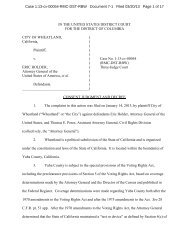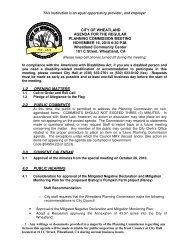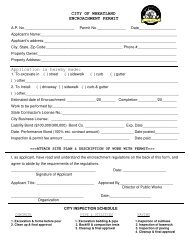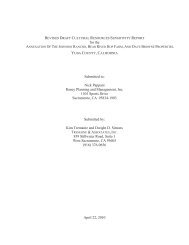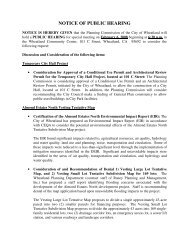General Plan Policy Document (Adopted 7-11 ... - City of Wheatland
General Plan Policy Document (Adopted 7-11 ... - City of Wheatland
General Plan Policy Document (Adopted 7-11 ... - City of Wheatland
Create successful ePaper yourself
Turn your PDF publications into a flip-book with our unique Google optimized e-Paper software.
GENERAL PLAN SUMMARYTheDonnerPartyin<strong>Wheatland</strong>1849GoldRushIncorporationHopFarmRiotsIn the 1840s Johnson’s Ranch was well known as the first settlementreached by the overland immigrants after crossing the Sierra and isconsidered to be the end <strong>of</strong> the Emigrant Trail. Here immigrantsrested and obtained supplies, and it was even the base for survivors <strong>of</strong>the infamous Donner Party after they were rescued in 1847.During the gold rush <strong>of</strong> 1849, placer gold was recovered from creeksand streams near <strong>Wheatland</strong>. The gold rush helped to quicklypopulate the region with prospectors, entrepreneurs, and othersseeking easy fortunes.During this time the first building were erected in <strong>Wheatland</strong>. Theseincluded a general store, saloon, blacksmith shop, hotel, and a fewresidences in the first year. It was not until 1871-72 that the sale <strong>of</strong>individual lots boomed.At the time <strong>of</strong> <strong>Wheatland</strong>’s incorporation in 1874, the population was900, <strong>of</strong> which 300 were Chinese. Most Chinese came to work on therailroad and service industries (laundries, restaurants, etc.) and laterwere employed as hop workers. A thriving Chinatown existed fromthe 1860s through the early 20th century, when anti-Chinese sentimentforced its relocation several times. The center <strong>of</strong> the Chinese burialrite was a ceremonial pyre near the <strong>Wheatland</strong> Cemetery where finalmeals were cooked for the deceased. The Chinese were buried nearbyuntil they could be shipped back to China for final internment.Another significant event in <strong>Wheatland</strong>’s history was the inauguration<strong>of</strong> Mayor Edward P. Duplex in 1888. Mayor Duplex was the firstAfrican-American man to be elected mayor <strong>of</strong> a western United Statescity. His barbershop still stands today on Main Street in downtown.Hop raising on a small scale was carried on in Yuba County aroundthe 1860s, and D.P. Durst planted the first hops in the <strong>Wheatland</strong> areain 1874. This ranch was the largest privately owned hops field in theworld and <strong>Wheatland</strong> soon became known as the “Hop Center.”Migrant workers throughout the region were drawn to Durst’s ranch.The Durst hop ranch was also the scene <strong>of</strong> one <strong>of</strong> the first labordisturbances in California history. In 1913, violence erupted at ameeting organized by the Industrial Workers <strong>of</strong> the World (IWW) toprotest low pay and intolerable living conditions <strong>of</strong> the hops pickers.The California State militia had to be called in to break up the riot,only after the sheriff, the district attorney, and two workers werekilled. The organizers <strong>of</strong> the strike were later convicted <strong>of</strong> murder andsentenced to life imprisonment.In the wake <strong>of</strong> this tragedy, Governor Hiram Johnson created acommission to investigate the condition <strong>of</strong> migratory farm laborers,<strong>Wheatland</strong> <strong>General</strong> <strong>Plan</strong> <strong>Policy</strong> <strong>Document</strong>, Part I 5July <strong>11</strong>, 2006



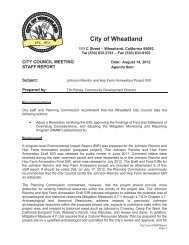
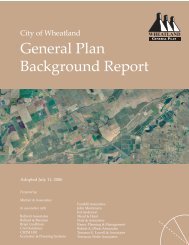
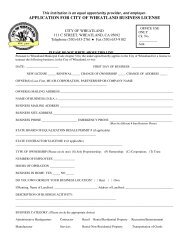


![[Read-Only].pdf - City of Wheatland - State of California](https://img.yumpu.com/37333564/1/190x146/read-onlypdf-city-of-wheatland-state-of-california.jpg?quality=85)
